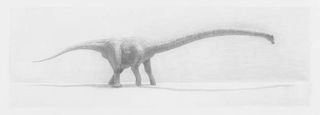Streeeetch! Long-neck Dinosaur Sets New Standard

Scientists have identified a new dinosaur species that had one of the longest necks relative to body length ever measured.
A typical neck bone in this creature was about the size of two loaves of bread.
The species, Erketu ellisoni, belongs to the group of massive four-legged herbivorous dinosaurs called Sauropoda, the largest land animals ever to walk on Earth. This giant group also includes Brachiosaurus, Diplodocus, and the largest of them all, the 120-foot long Argentinasaurus.
E. ellisoni had an extremely elongated neck. A single neck vertebra measures nearly two feet long, longer than the same vertebrae of the much larger Diplodocus carnegii.
"If you compare the index of elongation—how long vertebrae are compared to how long or tall the dinosaur is—to Diplodocus carnegii, [E. ellisoni's] vertebrae are longer, but even more stretched out from front to back," said study co-author Dan Ksepka, a graduate student at Columbia University who studies at the American Museum of Natural History in New York City.
The discovery was announced today.
Based on the specimen's partial remains, researchers estimate the neck was more than 24 feet long all together. However, estimates of body size, based on limb bones and not including tail, indicate the body was probably about half as long as the neck. This gives E. ellisoni one of the longest necks relative to body size of all sauropods.
Sign up for the Live Science daily newsletter now
Get the world’s most fascinating discoveries delivered straight to your inbox.
Researchers also recovered a chest plate, two lower leg bones, and a potato-sized ankle bone in Bor Guve in Mongolia's Gobi Desert in 2002. The bones were found among rocks deposited in a floodplain 120 million to 100 million years ago.
Museums and movies have long reconstructed sauropods in postures similar to a giraffe—with their heads held high, grazing hard-to-reach leaves. But based on how vertebrae fit together, recent studies and computer modeling suggest that these dinosaurs may actually have walked with their necks and heads held parallel to the ground.
"Based on what we know about other sauropods and what skeletal remains we do have, it looks like [E. ellisoni] had a similar posture," Ksepka told LiveScience.
That doesn't mean that they couldn't lift their heads, Ksepka said, just that this is how it probably was in a relaxed pose.
The giant vertebrae also shed light on how sauropods managed life with the burden of such long necks. The sides of the bones feature large concavities where air sacs would have existed, and scans reveal that the bones are not solid, but filled with numerous small pneumatic chambers that would reduce weight.
Also, unlike human vertebrae, the spines along the top of some vertebrae are split in two parallel tracks rather than one. This space may have been carved out for a ligament that helped support the neck.
"It's not acting to lift the head up, though," Ksepka said. "It's acting like a bungee cord to provide support to keep the neck held in horizontal position without having to fire muscles."
This track arose independently in several species of sauropods, but this is the first time it has been observed in a Titanosauria, a subgroup of Sauropoda of which E. ellisoni is a member.
- Gallery: Dinosaur Fossils
- The Biggest Carnivore: Dinosaur History Rewritten
- Animations Reveal How Dinosaurs Might Have Walked
- Dinosaur Find Raises Questions about the Origin of Feathers
- Dinosaurs that Learned to Fly
- A Brief History of Dinosaurs
Most Popular

